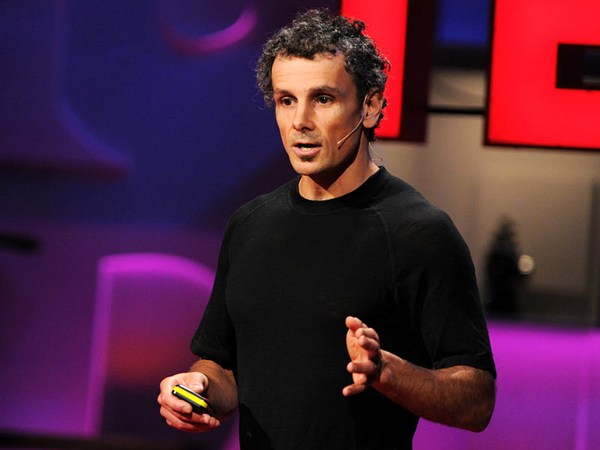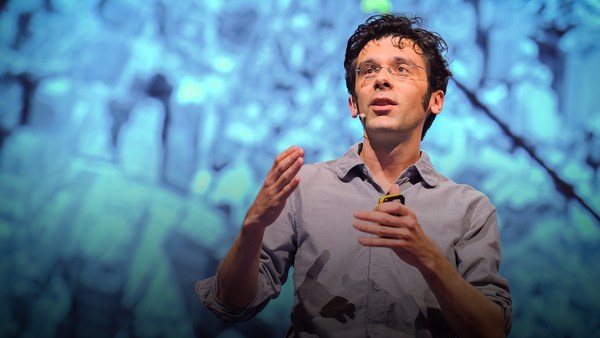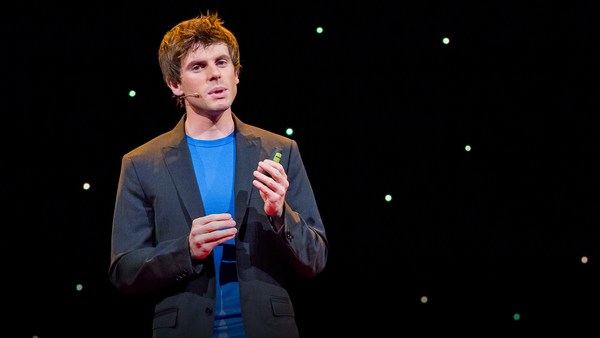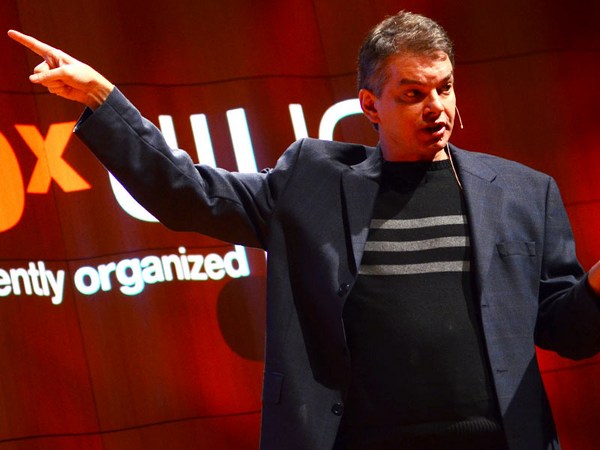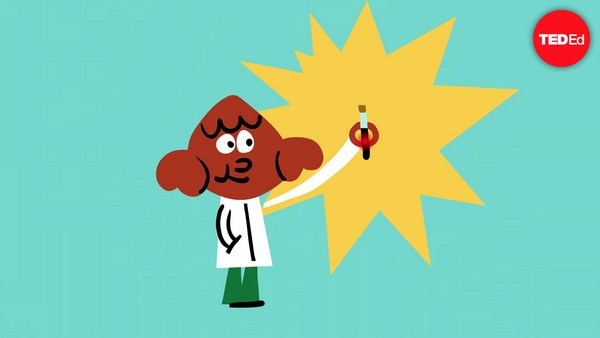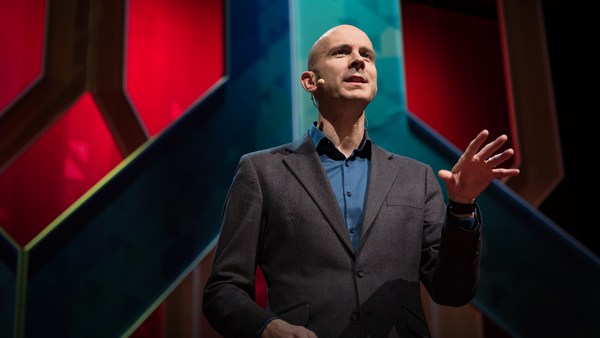Thanks very much. I am Hannah Fry, the badass. And today I'm asking the question: Is life really that complex? Now, I've only got nine minutes to try and provide you with an answer, so what I've done is split this neatly into two parts: part one: yes; and later on, part two: no. Or, to be more accurate: no?
(Laughter)
So first of all, let me try and define what I mean by "complex." Now, I could give you a host of formal definitions, but in the simplest terms, any problem in complexity is something that Einstein and his peers can't do. So, let's imagine -- if the clicker works ... there we go. Einstein is playing a game of snooker. He's a clever chap, so he knows that when he hits the cue ball, he could write you an equation and tell you exactly where the red ball is going to hit the sides, how fast it's going and where it's going to end up. Now, if you scale these snooker balls up to the size of the solar system, Einstein can still help you. Sure, the physics changes, but if you wanted to know about the path of the Earth around the Sun, Einstein could write you an equation telling you where both objects are at any point in time. Now, with a surprising increase in difficulty, Einstein could include the Moon in his calculations. But as you add more and more planets, Mars and Jupiter, say, the problem gets too tough for Einstein to solve with a pen and paper. Now, strangely, if instead of having a handful of planets, you had millions of objects or even billions, the problem actually becomes much simpler, and Einstein is back in the game. Let me explain what I mean by this, by scaling these objects back down to a molecular level.
If you wanted to trace the erratic path of an individual air molecule, you'd have absolutely no hope. But when you have millions of air molecules all together, they start to act in a way which is quantifiable, predictable and well-behaved. And thank goodness air is well-behaved, because if it wasn't, planes would fall out of the sky. Now, on an even bigger scale, across the whole of the world, the idea is exactly the same with all of these air molecules. It's true that you can't take an individual rain droplet and say where it's come from or where it's going to end up. But you can say with pretty good certainty whether it will be cloudy tomorrow. So that's it. In Einstein's time, this is how far science had got. We could do really small problems with a few objects with simple interactions, or we could do huge problems with millions of objects and simple interactions. But what about everything in the middle?
Well, just seven years before Einstein's death, an American scientist called Warren Weaver made exactly this point. He said that scientific methodology has gone from one extreme to another, leaving out an untouched great middle region. Now, this middle region is where complexity science lies, and this is what I mean by complex. Now, unfortunately, almost every single problem you can think of to do with human behavior lies in this middle region. Einstein's got absolutely no idea how to model the movement of a crowd. There are too many people to look at them all individually and too few to treat them as a gas. Similarly, people are prone to annoying things like decisions and not wanting to walk into each other, which makes the problem all the more complicated. Einstein also couldn't tell you when the next stock market crash is going to be. Einstein couldn't tell you how to improve unemployment. Einstein can't even tell you whether the next iPhone is going to be a hit or a flop. So to conclude part one: we're completely screwed. We've got no tools to deal with this, and life is way too complex.
But maybe there's hope, because in the last few years, we've begun to see the beginnings of a new area of science using mathematics to model our social systems. And I'm not just talking here about statistics and computer simulations. I'm talking about writing down equations about our society that will help us understand what's going on in the same way as with the snooker balls or the weather prediction. And this has come about because people have begun to realize that we can use and exploit analogies between our human systems and those of the physical world around us.
Now, to give you an example: the incredibly complex problem of migration across Europe. Actually, as it turns out, when you view all of the people together, collectively, they behave as though they're following the laws of gravity. But instead of planets being attracted to one another, it's people who are attracted to areas with better job opportunities, higher pay, better quality of life and lower unemployment. And in the same way as people are more likely to go for opportunities close to where they live already -- London to Kent, for example, as opposed to London to Melbourne -- the gravitational effect of planets far away is felt much less.
So, to give you another example: in 2008, a group in UCLA were looking into the patterns of burglary hot spots in the city. Now, one thing about burglaries is this idea of repeat victimization. So if you have a group of burglars who manage to successfully rob an area, they'll tend to return to that area and carry on burgling it. So they learn the layout of the houses, the escape routes and the local security measures that are in place. And this will continue to happen until local residents and police ramp up the security, at which point, the burglars will move off elsewhere. And it's that balance between burglars and security which creates these dynamic hot spots of the city. As it turns out, this is exactly the same process as how a leopard gets its spots, except in the leopard example, it's not burglars and security, it's the chemical process that creates these patterns and something called "morphogenesis." We actually know an awful lot about the morphogenesis of leopard spots. Maybe we can use this to try and spot some of the warning signs with burglaries and perhaps, also to create better crime strategies to prevent crime. There's a group here at UCL who are working with the West Midlands police right now on this very question. I could give you plenty of examples like this, but I wanted to leave you with one from my own research on the London riots.
Now, you probably don't need me to tell you about the events of last summer, where London and the UK saw the worst sustained period of violent looting and arson for over twenty years. It's understandable that, as a society, we want to try and understand exactly what caused these riots, but also, perhaps, to equip our police with better strategies to lead to a swifter resolution in the future. Now, I don't want to upset the sociologists here, so I absolutely cannot talk about the individual motivations for a rioter, but when you look at the rioters all together, mathematically, you can separate it into a three-stage process and draw analogies accordingly.
So, step one: let's say you've got a group of friends. None of them are involved in the riots, but one of them walks past a Foot Locker which is being raided, and goes in and bags himself a new pair of trainers. He texts one of his friends and says, "Come on down to the riots." So his friend joins him, and then the two of them text more of their friends, who join them, and text more of their friends and more and more, and so it continues. This process is identical to the way that a virus spreads through a population. If you think about the bird flu epidemic of a couple of years ago, the more people that were infected, the more people that got infected, and the faster the virus spread before the authorities managed to get a handle on events. And it's exactly the same process here.
So let's say you've got a rioter, he's decided he's going to riot. The next thing he has to do is pick a riot site. Now, what you should know about rioters is that, um ... Oops, clicker's gone. There we go. What you should know about rioters is, they're not prepared to travel that far from where they live, unless it's a really juicy riot site.
(Laughter)
So you can see that here from this graph, with an awful lot of rioters having traveled less than a kilometer to the site that they went to. Now, this pattern is seen in consumer models of retail spending, i.e., where we choose to go shopping. So, of course, people like to go to local shops, but you'd be prepared to go a little bit further if it was a really good retail site. And this analogy, actually, was already picked up by some of the papers, with some tabloid press calling the events "Shopping with violence," which probably sums it up in terms of our research. Oh! -- we're going backwards.
OK, step three. Finally, the rioter is at his site, and he wants to avoid getting caught by the police. The rioters will avoid the police at all times, but there is some safety in numbers. And on the flip side, the police, with their limited resources, are trying to protect as much of the city as possible, arrest rioters wherever possible and to create a deterrent effect. And actually, as it turns out, this mechanism between the two species, so to speak, of rioters and police, is identical to predators and prey in the wild. So if you can imagine rabbits and foxes, rabbits are trying to avoid foxes at all costs, while foxes are patrolling the space, trying to look for rabbits. We actually know an awful lot about the dynamics of predators and prey. We also know a lot about consumer spending flows. And we know a lot about how viruses spread through a population.
So if you take these three analogies together and exploit them, you can come up with a mathematical model of what actually happened, that's capable of replicating the general patterns of the riots themselves. Now, once we've got this, we can almost use this as a petri dish and start having conversations about which areas of the city were more susceptible than others and what police tactics could be used if this were ever to happen again in the future. Even twenty years ago, modeling of this sort was completely unheard of. But I think that these analogies are an incredibly important tool in tackling problems with our society, and perhaps, ultimately improving our society overall.
So, to conclude: life is complex, but perhaps understanding it need not necessarily be that complicated.
Thank you.
(Applause)
